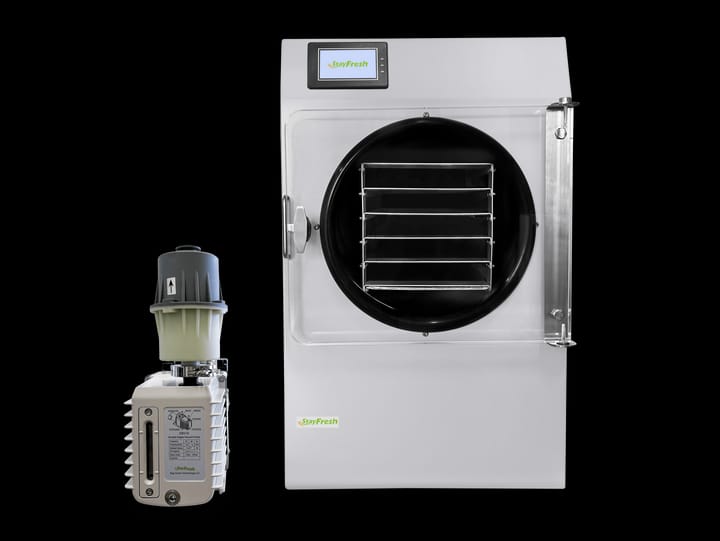In today’s world of food preservation and storage, freeze dryers are becoming an increasingly popular solution for households, small businesses, and large industries. Once considered specialized equipment for pharmaceutical labs and scientific research, freeze dryers are now accessible to everyday consumers who want to preserve food, flowers, or even pet treats for long-term use. This article explores what freeze dryers are, how they work, their benefits, common applications, and essential tips for choosing the right model.
What Are Freeze Dryers?
Freeze dryers, also known as lyophilizers, are machines that remove moisture from food or other materials while maintaining their structure, flavor, and nutritional value. Unlike traditional dehydration, which uses heat, freeze drying works by freezing the item and then reducing the surrounding pressure to allow the frozen water to sublimate directly from solid ice into vapor.
This unique process means that freeze-dried food maintains nearly all its nutrients, original taste, and appearance. For this reason, freeze dryers are widely used in industries like food production, pharmaceuticals, biotechnology, and even flower preservation.
How Do Freeze Dryers Work?
The process of freeze drying occurs in three main stages:
- Freezing – The product is cooled to a very low temperature, turning water content into ice.
- Primary Drying (Sublimation) – The pressure is reduced, and controlled heat is applied. This causes ice to sublimate, transforming directly into vapor without passing through a liquid stage.
- Secondary Drying (Desorption) – Remaining water molecules are removed, leaving the product extremely dry and stable for long-term storage.
Modern freeze dryers are designed with user-friendly interfaces, vacuum pumps, and digital controls that make the process easy, even for beginners.
Benefits of Freeze Dryers
Investing in freeze dryers offers a variety of advantages over other food preservation methods:
- Long Shelf Life: Freeze-dried foods can last 20–25 years when properly stored in airtight containers.
- Nutritional Preservation: Unlike heat drying or canning, freeze drying retains almost all vitamins, minerals, and antioxidants.
- Lightweight and Portable: With moisture removed, freeze-dried food becomes significantly lighter, making it ideal for camping, hiking, and emergency storage.
- Better Taste and Texture: Foods maintain their original shape, flavor, and color after rehydration.
- Reduced Waste: Freeze dryers help households store seasonal produce or leftovers instead of throwing them away.
Popular Uses of Freeze Dryers
While freeze dryers are well-known in industrial settings, their uses at home and in small businesses are expanding rapidly. Here are some of the most common applications:
1. Food Preservation
Homeowners use freeze dryers to preserve fruits, vegetables, dairy, meats, and full meals. This is especially helpful for families who want to stockpile healthy foods without worrying about spoilage.
2. Emergency Preparedness
Preppers and survivalists often rely on freeze-dried foods because they are lightweight, easy to store, and last for decades. Freeze dryers make it possible to create a personal emergency food supply.
3. Outdoor Adventures
Backpackers and campers appreciate the portability of freeze-dried meals. Simply add hot water, and the food is ready to eat.
4. Pet Food and Treats
Pet owners are now using freeze dryers to make healthy, natural treats for dogs and cats. Freeze-dried treats preserve protein content while avoiding artificial preservatives.
5. Flower Preservation
Florists and hobbyists use freeze dryers to preserve the shape and color of flowers for keepsakes, weddings, or home décor.
6. Pharmaceuticals and Biotechnology
In the medical field, freeze dryers are essential for stabilizing vaccines, enzymes, and other biological materials.
Choosing the Right Freeze Dryer
When shopping for a freeze dryer, several factors should be considered:
- Size and Capacity – Household freeze dryers typically come in small, medium, and large sizes. Choose based on how much food you plan to preserve.
- Power Requirements – Ensure the machine fits your home’s electrical setup, as some units may require more power.
- Vacuum Pump Type – Oil-based pumps are cheaper but require maintenance, while oil-free pumps are more convenient but costlier.
- Ease of Use – Look for freeze dryers with digital controls, automatic cycles, and clear instructions.
- Budget – Prices can range from $2,000 for smaller home units to over $10,000 for large commercial models. Consider your needs before making an investment.
Tips for Getting the Best Results
- Pre-Freeze Your Food: Cutting food into smaller pieces and freezing them before placing them in the freeze dryer improves efficiency.
- Store Properly: Use Mylar bags or airtight containers with oxygen absorbers for the best shelf life.
- Avoid High-Fat Foods: Foods with high fat content, like butter or peanut butter, do not freeze dry well.
- Regular Maintenance: Clean the trays and check the vacuum pump regularly to ensure long-term performance.
Final Thoughts
Freeze dryers are no longer just for laboratories or commercial food companies. With modern technology, they are now available to households and small businesses looking for reliable food preservation methods. From extending shelf life and reducing waste to preparing emergency supplies and creating lightweight meals for adventures, freeze dryers provide a wide range of benefits.
Whether you’re a homeowner interested in reducing food waste, a prepper building a long-term food storage plan, or a small business wanting to produce high-quality freeze-dried goods, investing in freeze dryers can be a game-changing decision.
